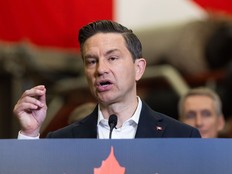Carney is patching up ties with Mexico in face of Trump threats

Article content
Canada is working to reset its ties with Mexico as Donald Trump threatens his neighbours with punishing U.S. tariffs ahead of a planned review of the North American free-trade pact.
Prime Minister Mark Carney sent his top diplomat and finance chief to the Mexican capital this week, where they met with President Claudia Sheinbaum and her officials, as well as corporate executives.
The move represents an attempt to patch over differences that arose during the final months of the previous Canadian administration, when provincial leaders mused about sidelining Mexico in trade talks with the US — and Carney’s predecessor refused to rule it out.
Trump hiked tariffs last week to 35% on Canadian goods that don’t comply with the continental free-trade agreement, in part because the northern nation retaliated against his levies. Mexico, which hasn’t hit back, was granted a 90-day reprieve while negotiations with the U.S. continue.
“This is an all-hands-on-deck moment for us to reignite the bilateral relationship,” Foreign Minister Anita Anand said in a phone interview as she wrapped up her two-day visit to Mexico City.
In addition to an hour-long discussion with Sheinbaum, Anand and Finance Minister Francois-Philippe Champagne also met with Mexico’s economy czar and energy chief. On the business side, their talks included representatives from Canadian Pacific Kansas City Ltd. railway, TC Energy Corp. and pension giant Caisse de Depot et Placement du Quebec.
During the meetings, both sides explored how Canadian companies and capital investors can help build infrastructure in Mexico that facilitates bilateral trade, including ports and rail, according to a person with direct knowledge of the talks. Strengthening energy security, including conventional and renewable power, was also discussed.
“This visit is part of Canada’s diversification strategy, to leverage the connection with Mexico,” said Diego Marroquín, a fellow at the Center for Strategic and International Studies in Washington who focuses on North American trade. But, he added, it was also about “damage control.”
Last year, before Trump returned to the White House to begin his second term, Ontario Premier Doug Ford and Alberta’s Danielle Smith publicly accused Mexico of not doing enough to counter trade threats from China and said Canada would be better off dealing with the U.S. alone. Then-Prime Minister Justin Trudeau echoed those concerns, which Mexico viewed as a betrayal.
That episode made it “more difficult for both countries to coordinate” on a response to Trump, Marroquín said. It’s also why Mexico is now pursuing a “quiet diplomacy strategy” while Canada focuses “more on retaliation and market diversification.”
Trudeau, deeply unpopular after nearly a decade in office, announced he was stepping down at the start of the year. Carney won the internal party race to succeed him and then called a snap election in April, with the former central banker capitalizing on a wave of anti-Trump sentiment to overcome a substantial polling gap and secure a fourth-straight Liberal mandate.
Since becoming prime minister, Carney has begun to mend ties with India and China after bitter diplomatic disputes. And in June, he invited Sheinbaum to the Group of Seven leaders summit he hosted in Kananaskis, Alberta. The Mexican leader attended with the main intention of meeting with Trump, but the U.S. president left before she arrived due to the Israel-Iran conflict.
The next step in recalibrating the relationship between the two junior partners of the North American trade deal will be a visit by Carney to Mexico. While it’s yet to be scheduled, Anand and Champagne laid the groundwork for it during their trip. “Given that Mexico is Canada’s third-largest trading partner, this is an extremely important relationship,” Anand said.
Carney’s visit would be the first for a bilateral meeting — without a U.S. president present — since Trudeau met with former President Enrique Peña Nieto in 2017. The Canadian leader returned to Mexico in 2023 for the “Three Amigos” summit with Joe Biden and Andrés Manuel López Obrador.
On the heels of Anand and Champagne’s talks in Mexico, Canadian Energy Minister Tim Hodgson said Thursday he met virtually with his counterpart Luz Elena Gonzalez to discuss how both countries can deepen collaboration. “There is real momentum in the Canada–Mexico relationship,” he said in a post on X.
“The Carney government has wisely decided to ramp up efforts to collaborate with Mexico,” said Laura Macdonald, a political scientist at Carleton University in Ottawa. It may not be so much a difference between the Trudeau and Carney governments, she added, but rather a recognition of “what has happened in the intervening period.”
Sheinbaum has been praised for her strategy in negotiating with Trump, who has said he respects her. That’s allowed the Mexican president to, if not avoid tariffs, at least put her country in a privileged position compared with other nations. Mexican Economy Minister Marcelo Ebrard said Anand and Champagne wanted to know more about her experience during their visit.
Although the U.S.-Mexico-Canada Agreement protects most exports to the U.S., both countries face tariffs on steel, aluminum and automobiles. While the two U.S. neighbours share common interests in the review of CUSMA (USMCA) scheduled for next year and should work together, they shouldn’t make a big deal of it, according to Carlo Dade, international director at the University of Calgary’s School of Public Policy.
“The first rule about fight club is don’t talk about fight club,” Dade said. “The last thing we want to do is make them think people are ganging up on them.”
Goldy Hyder, head of the Business Council of Canada, has been pushing for expanded trade with Mexico and met with Sheinbaum on the sidelines of the G-7. He commended the Carney government for trying to rekindle the relationship.
Mexico represents the “lowest-hanging fruit available” to boost Canada’s exports. “You don’t even have to send things there by ship,” he said. “This is an opportunity where we can diversify right on our continent before we start thinking about Europe or Asia or anywhere else.”
To Marroquín, the CSIS fellow, the warming of ties represents an opportunity to rebalance the US-focused continental trade partnership. “What was missing was political will,” he said. “That’s something that we lost after the comments from Premier Ford and Premier Smith.”
—With assistance from Thomas Seal.











Postmedia is committed to maintaining a lively but civil forum for discussion. Please keep comments relevant and respectful. Comments may take up to an hour to appear on the site. You will receive an email if there is a reply to your comment, an update to a thread you follow or if a user you follow comments. Visit our Community Guidelines for more information.